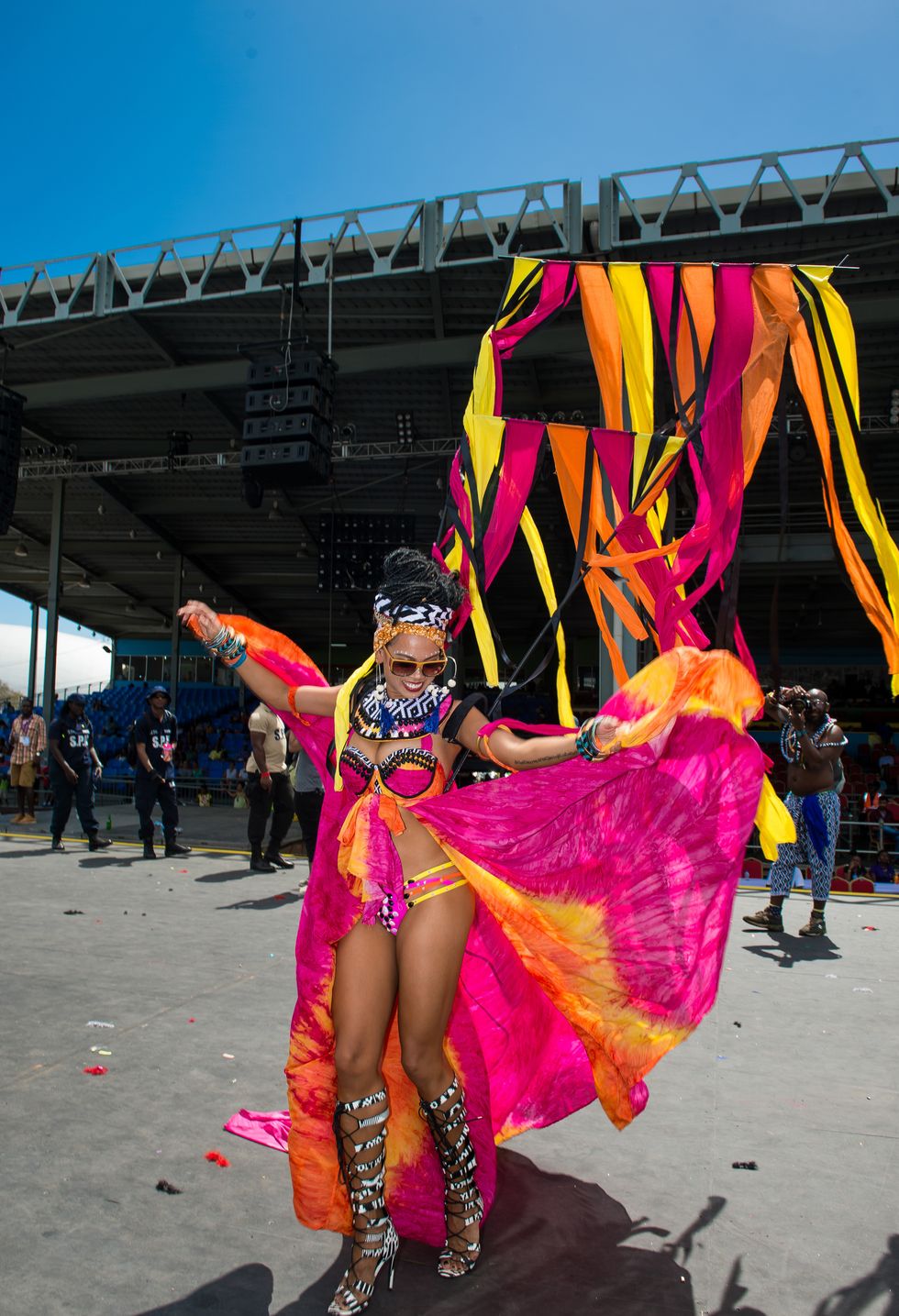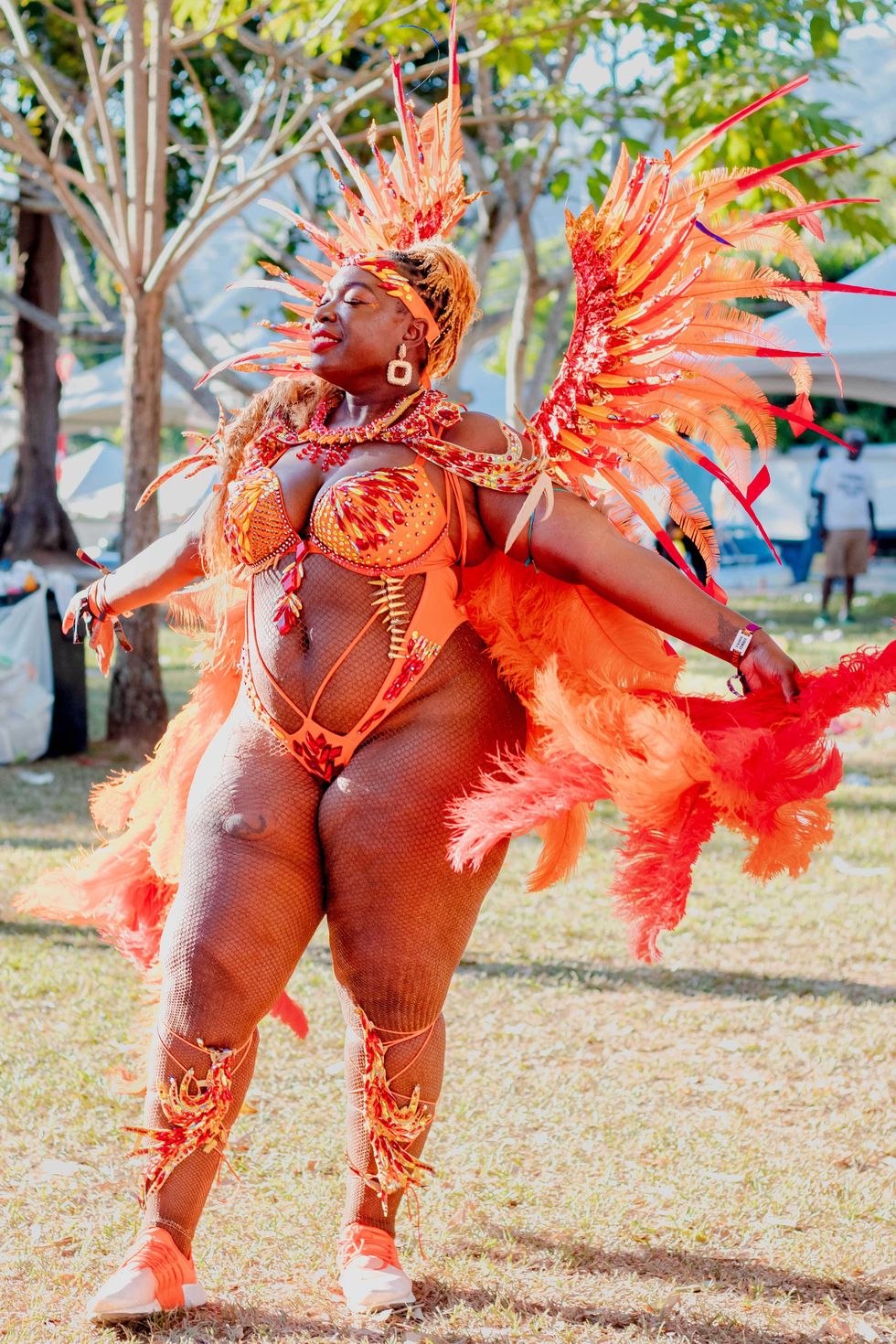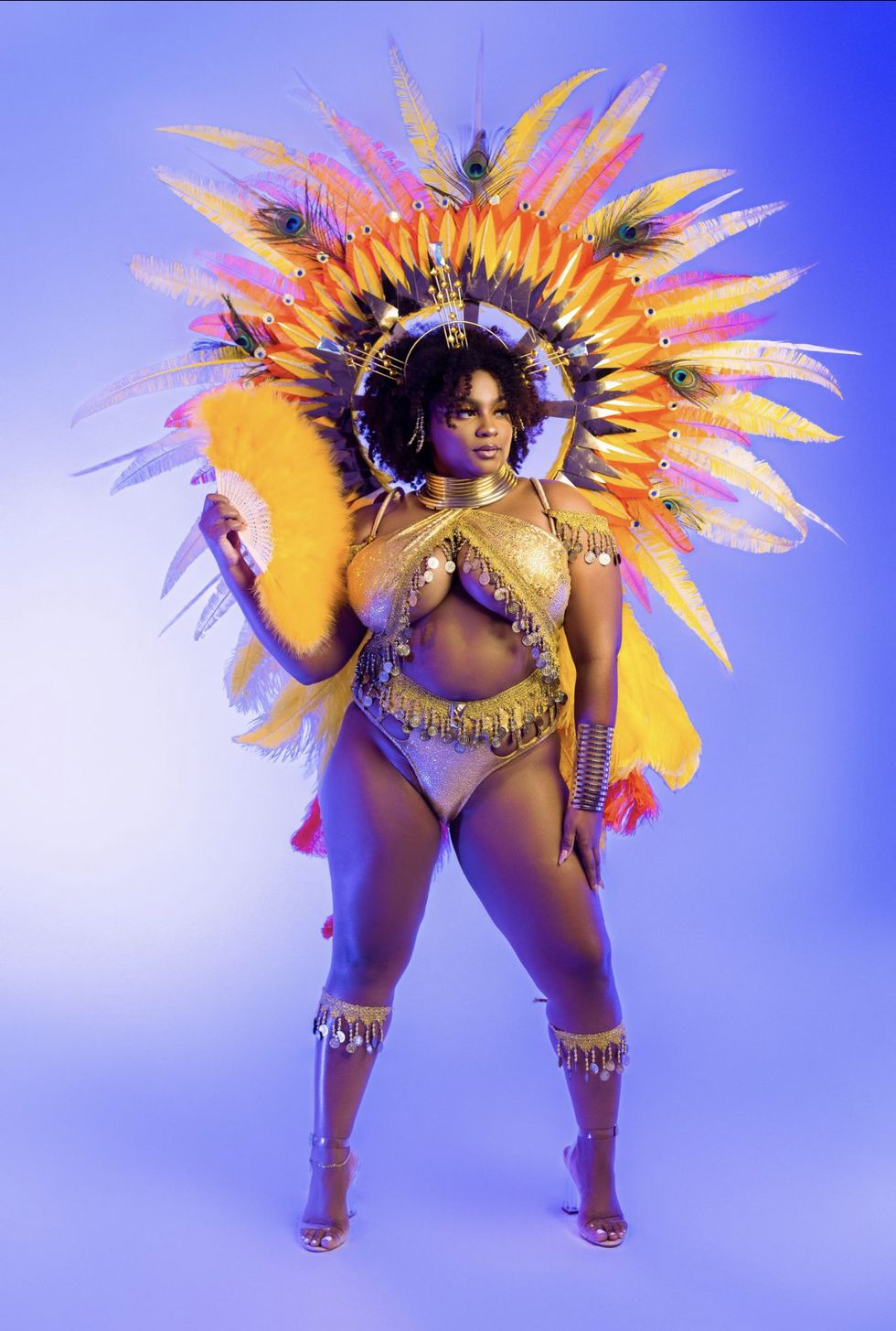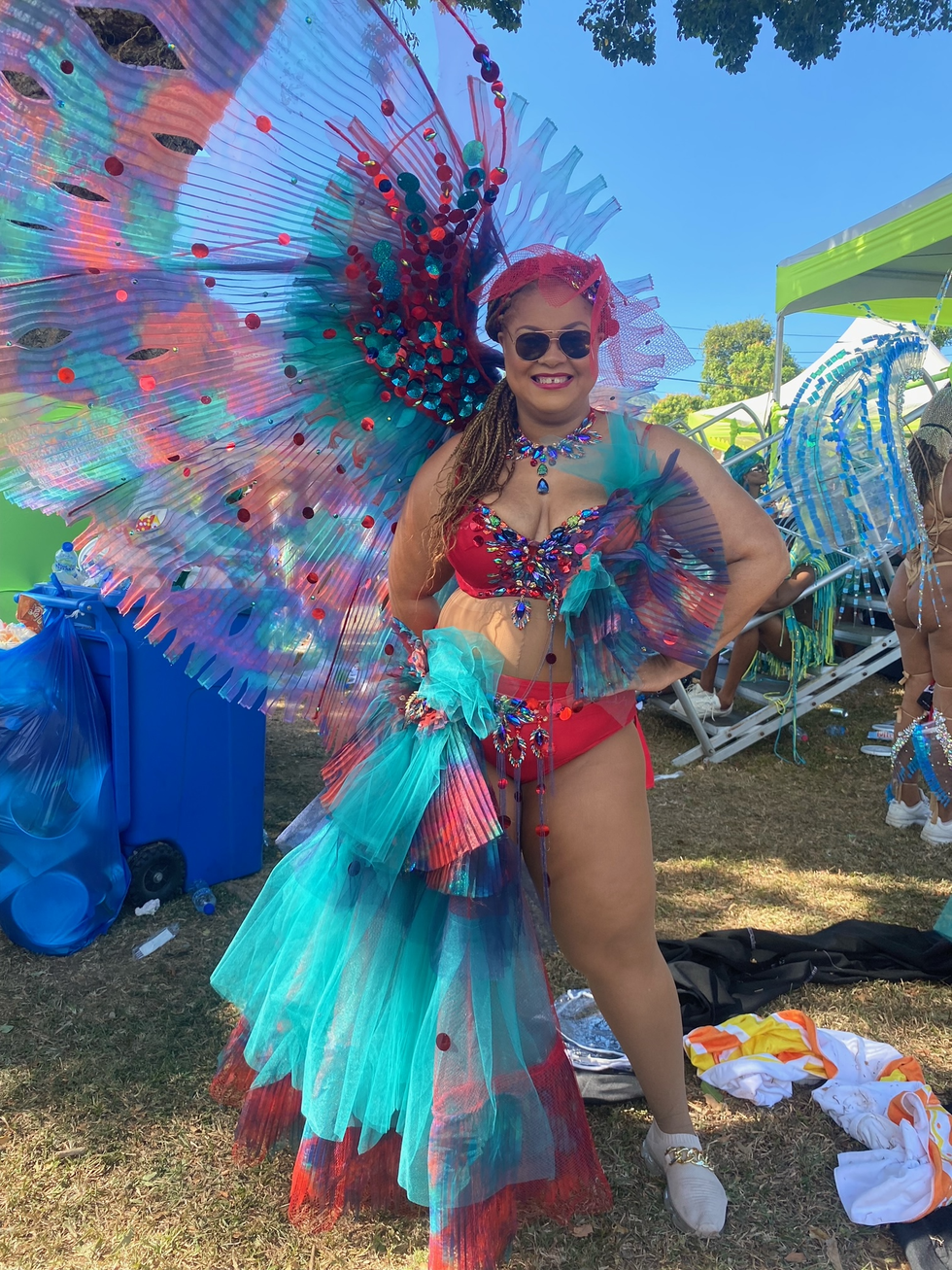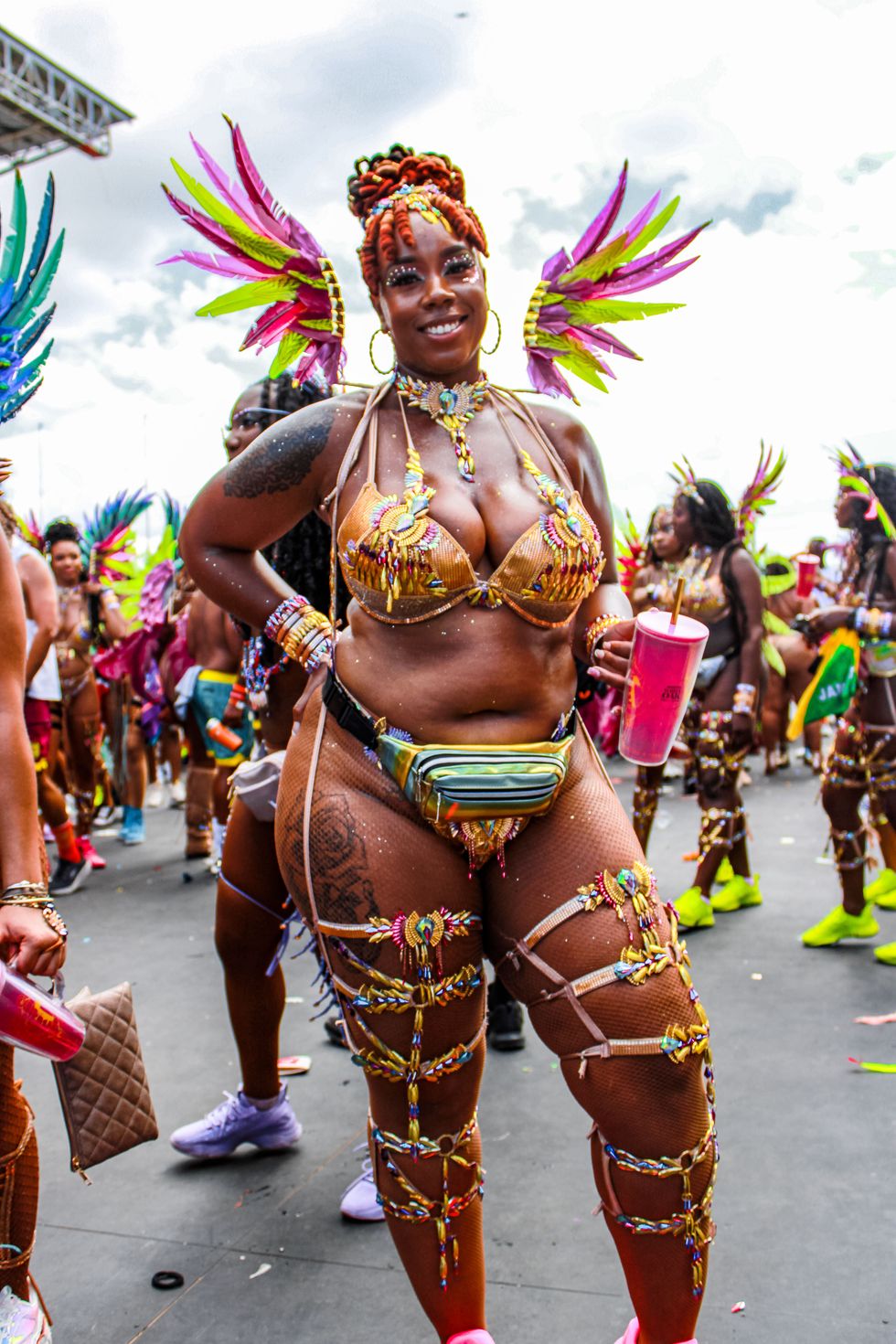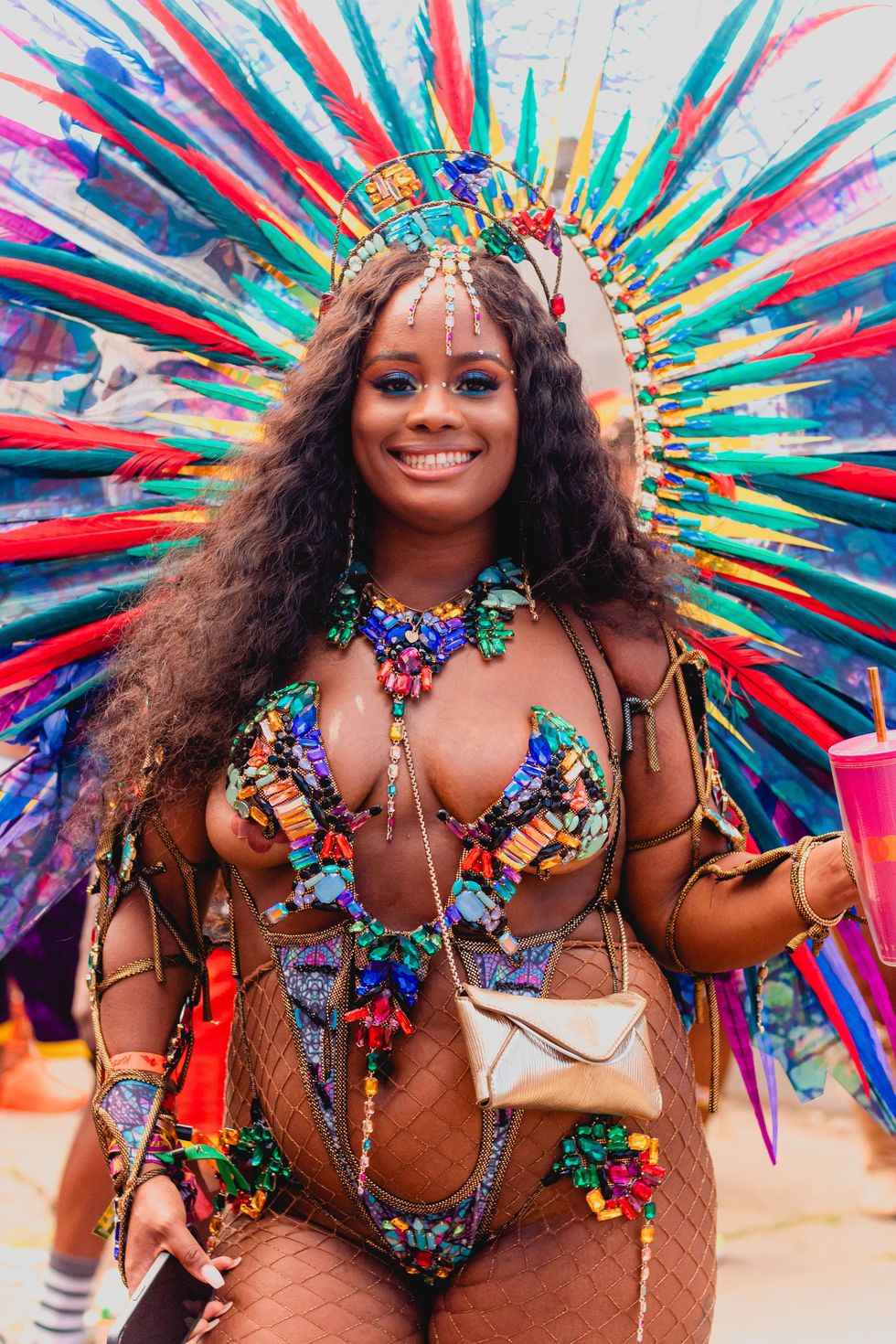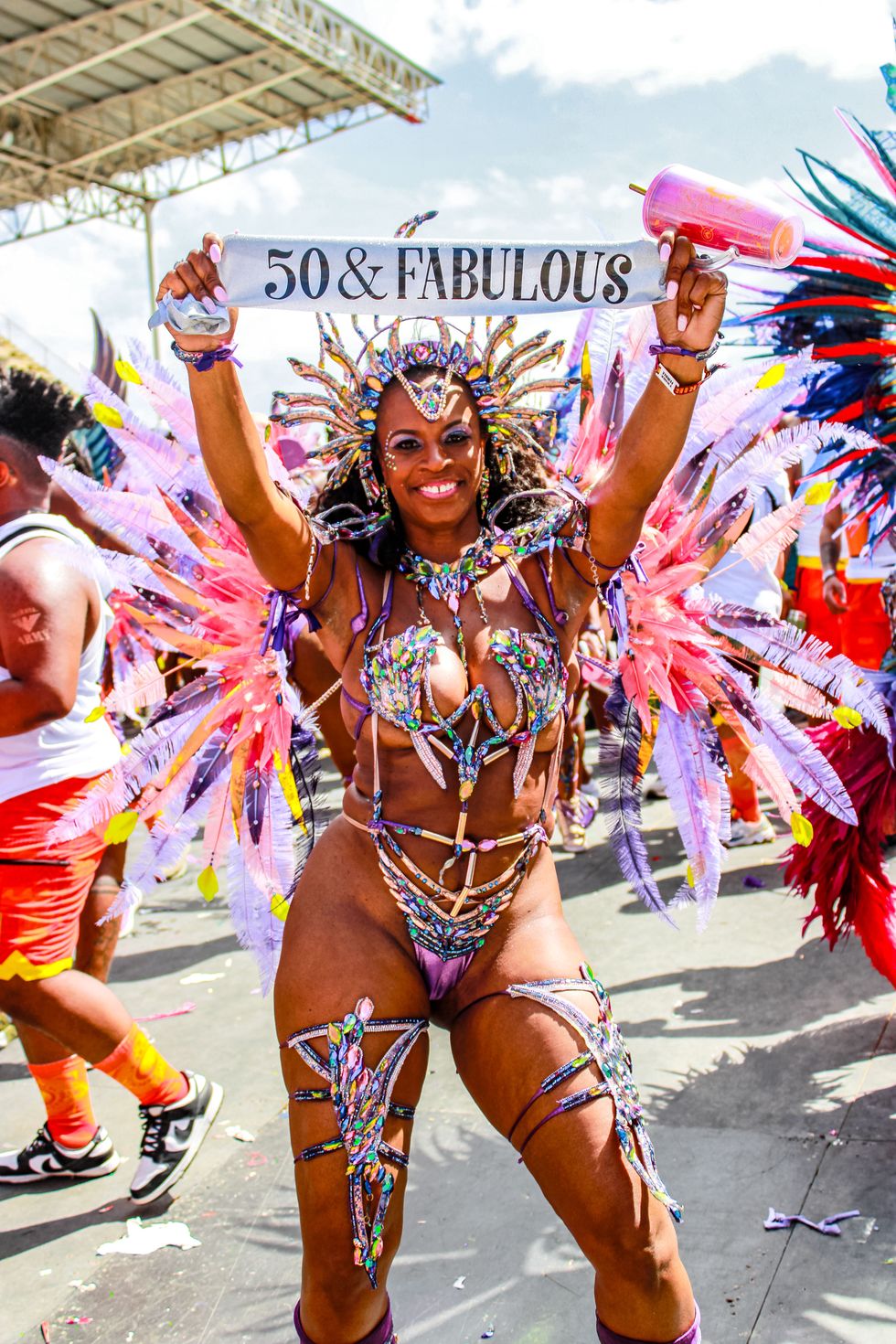For Project Runway Season 9 Winner Anya Ayoung-Chee, Carnival is a cultural rite of passage that is an inseparable part of her Trinbagonian DNA. Her Carnival Tuesday ritual is no different from the tens of thousands of costumed female revelers—known colloquially as “masqueraders”—that engage in a deliberate, exciting morning beauty routine in Trinidad and Tobago: methodically applying her long-lasting makeup, styling her hair to road-ready perfection, adorning her body in a stunning costume and getting ready for the 12-hour parade in glorious splendor. The transformation would have been particularly momentous for this mother of two, but that feeling of euphoria quickly gave way to a stinging reality when her post-pregnancy body elicited one single question from many masqueraders who greeted her during the festivities: “Are you pregnant again?”
Taking her frustration to social media, through her tears and waves of emotions, the former Miss Trinidad and Tobago posted on her Instagram that very day, firing back with a clear message: Women can take their time to snap back or maybe the miracle of giving life is much more powerful than hot body gyal pics.
“It’s just devastating that this should be a reason why women don’t participate in the mas experience during Carnival. It just triggered my self-esteem issues, but deeper than that… this conversation goes far beyond me. I don’t think we as women should have to be dealing with this,” she exclusively tells ELLE.com. While hundreds of supportive comments followed her social media post, real life paints a different reality for the Carnival ritual. For many women, Ayoung-Chee’s experience echoed a painful reminder of the harsh truths centered on conversations about the idealization of women’s bodies in Carnival.
“From a self-esteem and ego perspective, you know, the experience wasn’t great. I was already uncomfortable playing mas, having to select a costume from the very few body silhouettes that reflected not just me being a mother of two children, but also the age and stage of my life. Those comments just reinforced what I was already feeling, and I was dreading this possible outcome,” Ayoung-Chee candidly shares.
Body positivity has been a raging topic of conversation in diaspora social circles for quite some time. Known as the birthplace of it all, Trinidad Carnival is undoubtedly the center of all perennial regional and international activities. Similar to staple Fashion Weeks around the world, which set global trends, Trinidad’s culture defines costume trends during “Band Launch Season,” when mas camps, the place where Carnival costumes are created, debut their looks during the summer months in the year before the official parade. The vibe and attitude permeate other Caribbean Carnivals, including in the Bahamas, St. Vincent and the Grenadines, Barbados, St. Lucia, Grenada, and Jamaica’s Carnival, which took place on April 16. Back in 2019, Fuad Khan, Trinidad and Tobago minister of health from 2011 to 2015, came under heavy nationwide criticism for referring to a curvy masquerader as “a tub” and calling on her to lose weight. Now, with the rise in popularity of the dare-to-bare, “bikini and beads” mas, featuring scantily clad, colorful looks that are a departure from more traditional costumes, many masqueraders see the post-pandemic return of Carnival as an opportunity to revolt against the orthodoxy that only slender, fit women can wear these costumes, or even play “mas,” which is short for masquerade and is the act of dressing up, dancing in the streets to music, and crossing the stage to be judged as a group in your costume.
Dania Beckford, designer and founder of Broadtail Designs in Jamaica, is vocal about her uncompromising intention to empower women of diverse sizes during Jamaica Carnival. “Having the narrative that we should all fit into the same size costume is very flawed,” she reasons. Confidence and comfort no longer have to be a compromise, according to Beckford. Broadtail Designs was already a body-positive brand, and with the influence and partnership with Andrew Bellamy, managing director at Yardmas Carnival Band, the team knew that they wanted Beckford’s costume, entitled Oshun, in the band because of the range of sizing options and flattering styles for various body types.
“It’s very important for me that everyone has an opportunity to express themselves through culture. We live in the Caribbean—we don’t have European bodies, and we are shaped differently and have curvy hips, thick thighs, and fuller breasts. Jamaican women are curvy, and this larger picture depicts what most women look like in Jamaica,” Beckford says.
In Trinidad, Caribbean costume designer Sandra Hordatt is fighting body inclusivity one costume at a time. Following a two-year hiatus during the pandemic, Sandra pivoted from designing Carnival costumes and curated her very first large-scale Monday Wear collection for Trinidad Carnival, aptly called Radiate Love. Generally, the demand for Monday Wear, a term used to describe the ornate swimwear worn for Day 1 of the street parade—has increased exponentially in the last five years among visitors and residents of the twin-island republic. Launched in the final quarter of 2022, her risk was worth the reward and the response to her first offering under the Sandi’s Angels moniker was overwhelmingly positive, selling out in three short weeks after its debut medium. According to Hordatt, the proof is in the numbers: 30 percent of her Monday Wear customer orders were size large and higher, categorically rejecting the pressures to fit into a specific mold to be deemed physically “fit to play mas”.
As a seasoned arbiter of Carnival style with over 20 years of industry experience, Hordatt is particularly encouraged by the range of size requests that the team received in the months leading up to the return of Trinidad Carnival. “Sandi’s Angels’ slogan is Fashion For Everybody, and Every Body—so yes, I did see a lot of requests for different sizes this year. “Radiate Love” was specifically designed to flatter and support every body type,” she tells ELLE.com.
Masquerader and model Sonja Pollonais is all too familiar with the shame and prejudice that is often imposed on full-figured women in Carnival. “I’ve been plus-size all my life; I have one vague memory of me being skinny or slim, maybe at age 10 or 11,” she recalls. Having experienced inordinate and downright harrowing levels of discrimination because of her body type—including being abandoned backstage as a model by fashion designers at a runway show—Pollonais longed to create a community of love for women with similar experiences that would uplift, encourage, and support others. Her documentary-turned-festival Lights, Camera, Curves is a manifestation of that vision, and this year, her committee-affiliate Carnival band The Lost Tribe walked away with Trinidad Carnival’s Large Band of The Year title for the first time.
“Lost Tribe has created a space where everybody—no matter how you look, skin color, or body type—has an opportunity to play mas without judgment. It’s a safe space, and to know that a band that I would have contributed to creatively and that has been so welcoming was able to bring home this title, feels like a validating moment and a win for everybody. It shows that you can look beautiful at all sizes and all shapes, and I feel seen—they see me,” she explains.
And with good reason – according to an official Request For Data and Information on Trinidad and Tobago Carnival in 2021 from Trinidad’s Ministry of Tourism, Carnival visitor arrivals grew rapidly during the period 2001 to 2006, from roughly 25,000 to 43,000, with 9 percent of total arrivals for Trinidad and Tobago occurring within the three weeks preceding Carnival Monday. Planning one’s costume for “The Greatest Show on Earth” as a plus-sized masquerader can be a challenge, according to Crystal Wallace, founder and blogger at The Curve Experience; an online destination that highlights diversity in plus-size costumes and celebrates the beauty of full-figured masqueraders. “What motivated me to start my blog was the fact that there was barely any representation for plus-sized women in mas, and I really wanted to showcase that curvaceous women can feel comfortable in their skin like anyone else,” she explains. As an experienced masquerader who has traveled to seven Carnivals and modeled five costumes to date, she adds that there are three questions she receives often from first-time visitors: where to get costumes, the process of joining a band, and what bands are “curvy-friendly.”
“A lot of my followers trust me when it comes to recommending bands and designers just to make the process a bit easier. Not every curvy masquerader wants the same thing: some prefer to be a bit more covered, while others want something sexier. No matter what the personal preference is, they want a well-executed option, not one that feels like an afterthought,” Wallace says.
Identifying the core needs of female masqueraders while flourishing in his creative element is a signature skill that in-demand costume designer Shawn Dhanraj seems to repeatedly wield to his advantage. Nine years into his profession, Dhanraj continues to keep an open mind with his design techniques to meet the needs of his clients, a disproportionate number of whom are foreigners who travel to the Caribbean for Carnival. “Usually in the past, I would be designing for A to C cups, because that was the standard,” the beloved Trinbagonian creative admits. “After a while, I began to challenge myself to design costumes for a wider range and use my starting point with a 2XL or 3XL canvas. Appreciating women’s body types is so important—I’m a man, so I’m always learning from my female masqueraders and asking questions. ‘What are their concerns? What support do they need? How do I make them more comfortable?’” His approach to inclusivity paid off this year for Trinidad Carnival: His costumes in The Lost Tribe, as well as other offerings in TRIBE and BLISS, sold out in one month. “So, whether it’s extra mesh or additional elastic, I listen to women and my craft benefits from those methods,” Dhanraj explains.
Anya Ayoung-Chee would like to see a turning of the page for the regional Carnival experience as it preserves the culture. “It’s complex because there is an ecosystem of reasons why things are the way that they are. The one-note costume silhouette is a function of the top-down pyramid nature of how decisions are made about these costumes,” she explains. Drawing on powerhouse fashion brand Savage X Fenty as an example of intentional inclusivity, she notes that urgent remedial action needs to be taken to factor in the needs of the costumed Carnival consumer. “The commercialization of Carnival is 100 percent anchored on the male gaze, and that is as a result of a decision-making issue on what goes to market—not just for costumes in Trinidad, but for our music and other elements. It’s layered and parallel and requires a massive cultural shift.” Wallace hopes that the presentation of curvy options is not just a short-term trend and that masqueraders see the representation reflected at band launches. “Put a curvy girl in a curvy option on stage. We want to see how the costumes move on our bodies, the materials, and most importantly I want to see a girl who looks just like me in that costume,” she says.
And as for masquerader Sonja Pollonais, she plans to hold mas designers accountable for providing more options for full-figured women, and is challenging stakeholders with a steely and unrelenting call to action. “The costume designers now are more focused on the skimpiest aesthetic—which is okay, but it also represents a very small percentage of the average masquerader on the road,” she says. Her request is not that designers change their unique aesthetic; however, but that designers keep an open mind about costume accessibility to various body types, including the plus-sized masquerader. “You can offer small variations to the costume fit to accommodate your masqueraders with real-sized bodies—varying boobs, stomachs, hips, and butts. COVID has changed a lot of what we do, including the way we look at our bodies. Thankfully, social media in the Carnival circuit has now created an authentic space for people to embrace, enjoy, be, and love who they are,” Pollonais says.
For her and many women demanding more support for body positivity in Carnival, there is hope on the horizon. Just maybe, the radical masquerader who decidedly takes up space—and now understands her consumer power of choice, where money talks—is the audacious, fearless answer from the Carnival Gods that the community desperately needs, to finally change for the better.
